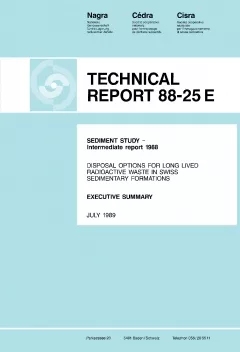
Technischer Bericht NTB 88-25
Sediment StudyDisposal options for long-lived radioactive waste in Swiss sedimentary formationsExecutive summary
In the current Swiss nuclear waste disposal concept, vitrified highlevel wastes (HLW) and some long-lived intermediate-level wastes will be included in a deep geological Type C repository. The Project Gewähr 1985 study demonstrated, in principle, the safety of such a repository situated in the granitic bedrock of Northern Switzerland. An ongoing geologic investigation programme is aimed at locating potential repository siting regions.
In parallel to the crystalline programme, Nagra is also investigating the potential of sedimentary formations to host such a Type C repository. The consideration of this option has also been recommended by the Swiss Regulatory Authorities in their review of Project Gewähr 1985. Furthermore, the authorities have recommended that such vertically accessed sediments should also be considered for a wider range of intermediate-level waste sorts which have been previously allocated to a horizontally accessed Type B repository. This intermediate report documents the first stage of investigation of deep sediments aimed at fulfilling both the above objectives.
Unlike the crystalline basement, an extensive literature exists for the Swiss sediments and an evaluation and synthesis of this literature comprises the major part of this report. Based on a number of criteria, the total inventory of sedimentary formations in Switzerland can be narrowed down and regionally constrained. The requirement for a tectonically quiet and simply structured region constrains the area studied to the Swiss Low Land (Mittelland), Aargauer-Schaffhauser Tafeljura and the Ajoie. Reviewing the sedimentary inventories of these regions with regard to constraints of simple structure, sufficient thickness and low permeability allow 7 potential host rocks to be identified for more detailed consideration: Obere Süsswassermolasse, Untere Süswassermolasse (USM), Effinger Schichten, Opalinus-Ton, Gipskeuper, Mittl. Muschelkalk (Anhydritgruppe) and Permian. These formations are then considered further in regions in which they could be found at suitable depths (between 300 and 1’200 m) in terms of stratigraphy, tectonics, hydrogeology, geochemistry and potential resource conflicts. From this analysis, two formations are selected as being most promising for further study, the Opalinus-Ton and USM.
The Opalinus-Ton and USM are further analysed to determine civil engineering constraints on repository constructions, extensive hydrologic modelling is carried out and preliminary analyses of safety performance are carried through. The civil engineering study indicated a similar design to that considered in Project Gewähr 1985 was feasible although smaller diameter HLW emplacement tunnels and a mechanical supportive tunnel lining would be required. The maximum practicable construction depth for such a design would be ≈1’000 m for both formations. The hydrologic models indicated that potentially large hydraulic potentials could exist over these formations giving rise to large gradients, particularly for the somewhat thinner Opalinus-Ton. The modelling was, however, severely constrained by the scarcity of appropriate input data and predicted gradients were shown to be sensitive to parameter value and boundary condition assumptions. The safety analysis indicated that safe disposal could be possible in either formation with negligibly small resultant doses to man. This analysis was, however, very sensitive to assumptions regarding the detailed flow system through the formation. Relatively small thicknesses of good clay (in the order of tens of metres) are quite sufficient to guarantee effective containment of all radionuclides, but potential short circuits due to shear zones or sand channels (in the USM) must be taken into account. The latter are particularly difficult to model in a realistic manner due to their complex structure and poorly understood retardation properties. The performance of the near field is shown to be relatively independent of host rock and is similar for both sediments to that expected in the crystalline. In the sediments, however, geochemical alteration of the host rock due to the presence of the repository may be more important than in the crystalline case.
Finally, 6 potential Opalinus-Ton regions and 2 USM siting regions were examined in more detail, with particular reference to tectonic conditions and suitable formation depth. From these, 2 potential siting regions for Opalinus-Ton (“Zürcher Weinland” and “Region nördlich der Lägeren”) and one for USM (“Region östlich der Limmat”) were selected for further studies. An outline of the programme of work required to further reduce these to a single first priority sediment site is also presented. In the next phase of the study, increased attention will be devoted to studying exploration strategies in the 2 sediments with the aim of quantifying the effort needed for an appropriate level of geologic characterisation for more detailed development of disposal projects.
